|
Verax P14Cu From All Angles |
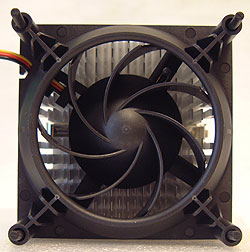 |
The Fan:
The seven bladed impeller
on this 25mm thick fan creates a small amount of airflow
and practically zero noise. Compared to a traditional heatsink, the CAIRdB is pretty
revolutionary - but it is important to keep in mind
that this heatsink is not really meant for overclockers - rather zero noise systems. The fan uses
two NIRO ball bearings and is temperature controlled to run at 1000-3500RPM (20C-45C)
depending on temperature. The fan connects to the
motherboard via a 3-pin fan header which supports RPM monitoring.
|
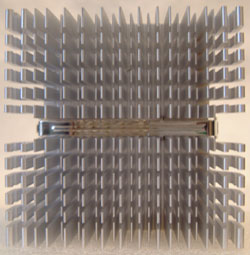 |
Top: The heatsink is based on a very wide spacing of pins and uses
a locking clip design to prevent shifting once installed on the processor. The extrusion
is pretty simple and what makes it really
interesting is that the fan attaches with not screws, but small rubber feet that lock into everything into place. The
rubber mounts help to prevent vibration from moving through the heatsink and potentially causing other noises in the
case. |
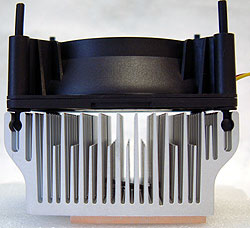 |
Side
A: The fins on the extrusion are
all rather thick to what
is the standard these days. However with the relatively low amount of air flow that comes
from the fan the spacing is probably well suited. The little rubber feet which
hold the fan in place lock into small circular holes in the frame of the heatsink. The
aluminum base measures 4mm thick, and the copper base plate 3mm thick. The
fins range from 3.75mm - 1.5mm at the tips. Fins are spaced ~3mm apart at the
base.
|
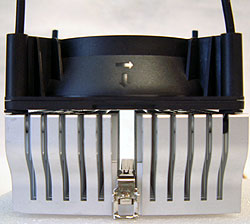 |
Side B:
The side of the heatsink has an assortment of
cross cuts which help to increase surface area and induce turbulence within the
fin structure of the heatsink. The clip is tool based but works well. Given the
overhang of the heatsink extrusion as it transitions from a base width of
64mm to 80mm make it impractical to use a
thumb clip. |
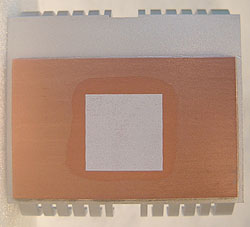 |
Heatsink Base:
The copper base has a matt finish and is slightly domed at
the center. A small amount of lapping would probably further improve the
performance of the entire heatsink. A square of silicon thermal
compound comes pre-applied to the base of the
copper. |


